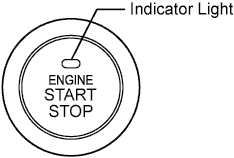Entry And Start System -- System Description |
| ENTRY AND START DESCRIPTION |
The push-button start function uses a push-type switch, which the driver can operate by merely carrying the key. This system consists primarily of the main body ECU, engine switch, ID code box, steering lock ECU, key, ACC relay, IG1 relay, IG2 relay and certification ECU. The main body ECU controls the system. This function operates in cooperation with the entry and start system. The table below shows the transition of the engine switch, which depends on whether the brake pedal is depressed or released.
This system has different power source mode patterns depending on the brake pedal condition.
When the battery of the key is low, the push-button start function can be operated by holding the key against the engine switch.Brake Pedal Power Source Mode Pattern Not depressed, shift lever in P Each time engine switch is pushed - off → on (ACC) → on (IG) → off
Not depressed When engine switch is pushed in engine started condition - Engine started → off
Depressed, shift lever in P or N When engine switch is pushed once - off → engine start
Depressed, shift lever in P or N When engine switch is pushed in on (ACC) condition - on (ACC) → engine start
Depressed, shift lever in P or N When engine switch is pushed in on (IG) condition - on (IG) → engine start
Depressed When engine switch is pushed in engine started condition - Engine started → off
- off → on (ACC) → on (IG) → off
| FUNCTION OF COMPONENT |
| Components | Function |
| Engine Switch (Transponder Key Amplifier) |
|
| Key |
|
| Indoor Electrical Key Oscillator |
|
| Door Control Receiver |
|
| Main Body ECU |
|
| Certification ECU |
|
| Park/Neutral Position Switch |
|
| Stop Light Switch |
|
| ID Code Box |
|
| ECM |
|
| SYSTEM FUNCTION |
| Control | Outline |
| Engine Switch Control |
|
| Diagnosis |
|
| CONSTRUCTION AND OPERATION |
 |
Engine switch:
The engine switch consists of a momentary type switch, 2 color (amber, green) LEDs, and transponder key amplifier.- The amber and green LEDs are for the indicator lights. The driver can check the present power source mode and whether the engine can start or not in accordance with the illumination state of the indicator light.
- When the main body ECU detects an abnormality in the entry and start system, it makes the amber indicator light flash. If the engine stopped in this state, it might not be possible to restart it.
- The amber and green LEDs are for the indicator lights. The driver can check the present power source mode and whether the engine can start or not in accordance with the illumination state of the indicator light.
Indicator light condition:
Engine switch indicator light condition Power Source Mode/Condition Indicator Light Condition Brake pedal released Brake pedal depressed, shift lever in P or N Off OFF Illuminates (green) On (ACC, IG) Illuminates (amber) Illuminates (green) Engine running OFF OFF Steering lock locked Flashes (green) for 30 seconds Flashes (green) for 30 seconds System malfunction Flashes (amber) for 15 seconds Flashes (amber) for 15 seconds Stop light switch with shift lever in P or N malfunction Flashes (green) for 15 seconds Flashes (green) for 15 seconds Main body ECU:
The main body ECU consists of the IG1 and IG2 relay actuation circuits and CPU.
| SYSTEM NOT OPERATING NORMALLY (DUE TO KEY BATTERY DEPLETION, ELECTRICAL NOISE, ETC.) |
 |
To operate the push-button start function when the key battery is low, hold the key so that its TOYOTA mark is against the engine switch while depressing the brake pedal with the shift lever in P or N.
The main body ECU transmits a key verification request signal from the stop light switch to the certification ECU.
The certification ECU does not receive an ID code response from the door control receiver, so it actuates the transponder key amplifier built into the engine switch.
The transponder key amplifier outputs an engine immobiliser radio wave to the key.
The key receives the radio wave, and returns a radio wave response to the transponder key amplifier.
The transponder key amplifier combines the key ID codes with the radio wave response, and transmits it to the certification ECU.
The certification ECU judges and verifies the ID code, and transmits a key verification OK signal to the main body ECU. The buzzer in the combination meter sounds at the same time.
After the buzzer sounds, with the shift lever in P or N, if the engine switch is pressed within 5 seconds with the brake pedal not depressed, the power source mode changes to on (ACC) or on (IG), the same as in the normal condition.
| DIAGNOSIS |
When the ECU detects a malfunction, the amber indicator light of the engine switch flashes to warn the driver. At the same time, the ECU stores the 5-digit DTC (Diagnostic Trouble Code) in memory.
- The indicator light warning continues for 15 seconds even after the power source mode is changed to off.
- The DTC can be read by connecting the intelligent tester to the DLC3.
- The push-button start function cannot be operated if a malfunction occurs.